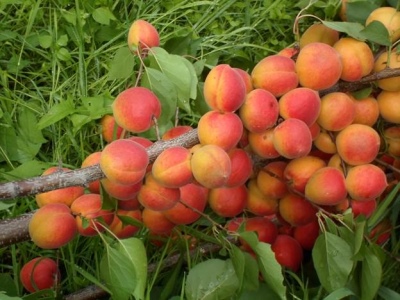
- Authors: G.T. Kazmin (DalNIISH)
- Year of approval: 1979
- Escapes: medium thickness, straight, reddish-brown on the sunny side, greenish on the back
- Flowers: large, pink, goblet
- Fruit weight, g: 26,2-32,4
- Fruit shape: rounded-elongated, beak-shaped towards the apex
- Skin : thin, velvety pubescent
- Fruit color: bright yellow, on the sunny side covered with a bright carmine blush, with dark carmine dots
- Pulp color : Orange
- Pulp (consistency): tender, dense, medium juicy, crispy
When choosing an apricot variety for planting in the country, you should pay attention first of all to the simplicity of agricultural technology and growing conditions, and then be interested in yield, appearance, especially if there is no experience in growing fruit crops. The unpretentious varieties include Amur apricot.
Breeding history
Apricot Cupid is a popular variety of domestic breeding, created at the Far Eastern Research Institute of Agriculture more than 70 years ago. The creators of this species are the scientists G. T. Kazmin and V. A. Marusich. Apricot Best Michurinsky and a mixture of pollen of 4 varieties were used as parental forms. Apricot was added to the State Register of Varietal Crops in 1979. Ideal for growing in the middle zone of the Russian Federation. In addition, apricot is productive in the climatic conditions of the Far East, the Urals and Siberia.
Description of the variety
Cupid is a compact, medium-sized tree with a half-stemmed trunk and a rounded-elongated crown shape, which is heavily thickened with emerald-green foliage that does not fall until the very frost. The tree is characterized by the growth of branches at right angles, as well as the perfect smoothness of the bark with a huge number of lentils. The tree grows rather slowly. In a favorable environment, an adult tree reaches a height of 3 meters, and the crown diameter does not exceed 3.5 m.
Apricot blooms in mid-May. During this period, the tree is densely covered with large pink goblet flowers, exuding an incredible aroma.
Fruit characteristics
Cupid is a small-fruited variety characterized by an unusual shape of the fruit - round-elongated with an elongated tip. The average fruit weight is 26.2-32.4 g. A ripe apricot has a bright yellow color, diluted on the sunny side with a blurred in the form of spots and dots carmine blush. The peel of the fruit is thin, dense, velvety, but not even. The apricot is kept on a shortened stalk. The abdominal suture is weak.
The advantage of the variety is considered to be good transportability, slow softening of fruits and long shelf life - up to 2 weeks. The purpose of table apricots is universal. Fruits are eaten fresh, processed into jams, preserves, compotes, canned whole, and also massively used in cooking.
Taste qualities
This apricot variety is famous for its excellent taste and marketability. The pale orange flesh has a fleshy, tender, crunchy, firm and rather juicy texture. The taste of the fruit is balanced - sweet and sour, complemented by a refreshing aroma. A medium stone with a sweetish core is easily separated from the fruit pulp.
Ripening and fruiting
Apricot is characterized by a medium ripening period. The first harvest is expected 3-4 years after planting. The tree bears fruit annually, without passes. You can taste the fruits in the second week of August.The peak of mass ripening occurs in the 2-3 decade of August.

Yield
The yield indicator is high. On average, one tree produces 35 to 45 kg of apricots. Trees 5-7 years old are distinguished by the highest yield, from which about 50 kg can be removed.
Self-fertility and the need for pollinators
The variety is partly self-fertile, therefore additional cross-pollination should be provided. Apricots varieties Akademik, Khabarovsky and Kichiginsky, planted at a distance of 3 meters, are perfect as donor trees.
Growing and care
Planting an apricot seedling is carried out in April or early October. The seedling must be one to two years old with a developed root and a height of at least 100 cm. Undesirable neighbors for the culture are cherry, plum and pear.
Care includes basic procedures - regular watering, despite the fact that the tree is drought-resistant, fertilizing three times per season, plowing and weeding the soil, preventing diseases, shaping the crown, removing dry branches, mulching and preparing for frost.



Disease and pest resistance
Cupid is endowed with high immunity to fungi and clasterosporium disease, but moderately resistant to moniliosis. In case of mistakes in agricultural technology, the tree can be attacked by insect pests - moths, aphids and leaf rollers.

Winter hardiness and the need for shelter
Cupid is the owner of high frost resistance, therefore, he firmly tolerates temperature drops to -35 ... 38. To prevent young growths from freezing, good mulching for the winter and wrapping in linen (burlap, spruce branches) is recommended.
Location and soil requirements
The apricot is planted in a sunny area, protected from cold wind and drafts, it is good if it is a small hill, since moisture stagnation for the root system of the tree is unacceptable. The soil should be fertile, loose, air and moisture permeable, and also have neutral acidity. The root system of the tree grows strongly in depth and width, therefore, space is needed, a deep flow of groundwater.































































